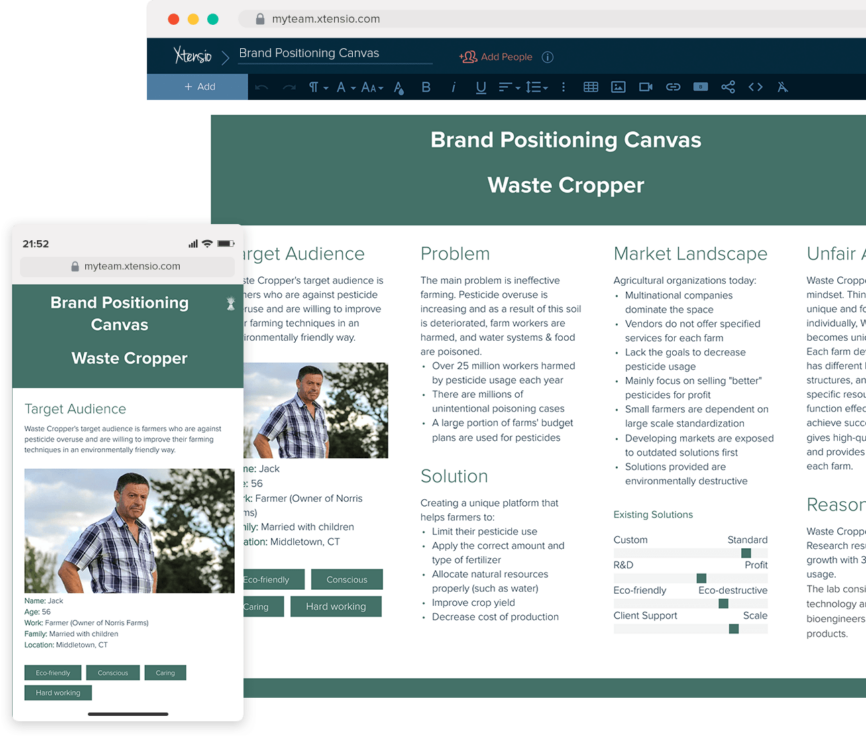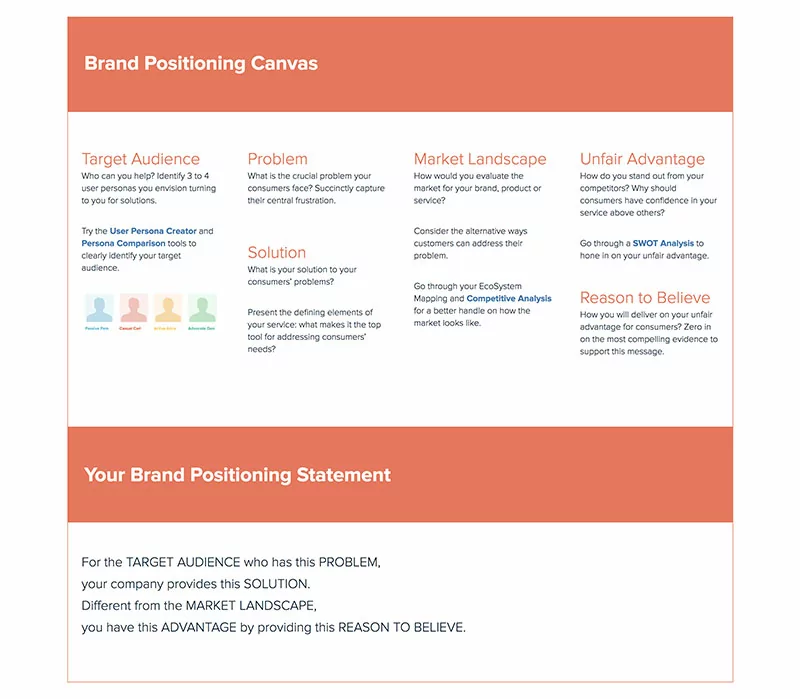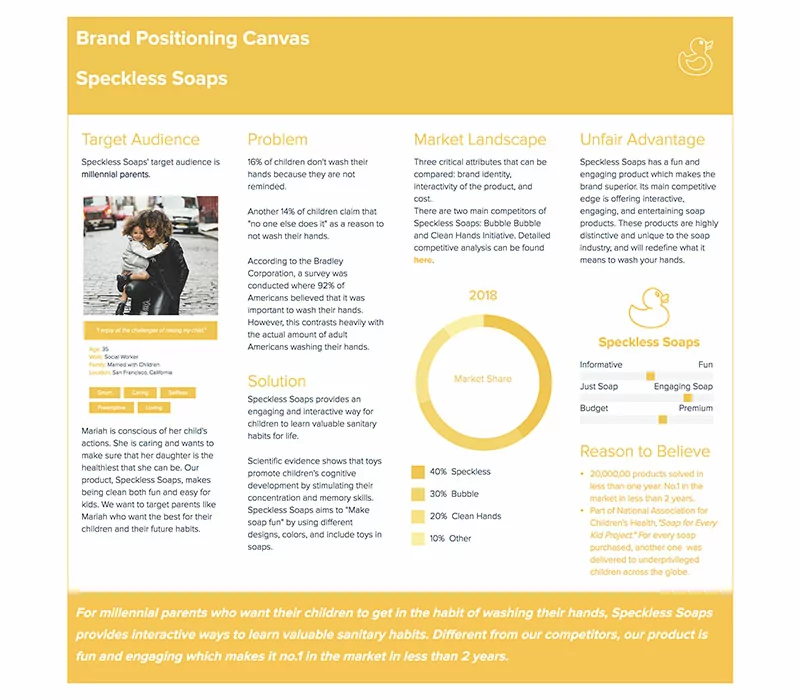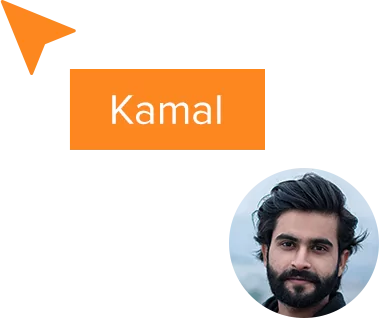How To Do Brand Positioning (With Template and Examples)
Updated by Xtensio
Determining how your company will stand out in the real world is a delicate undertaking. Completing the Brand Positioning Canvas will walk you through the motions of establishing how your product or service will be developed and how its story will be told to your customers. This is a vital internal study to set a strong strategic foundation for the long haul and it will sync your team’s actions under the same values. You will be digging for the core, the soul of your business. Now let’s get to it! Explore this template.
Xtensio is your team space for beautiful living documents.
Create, manage and share business collateral, easily.
Table of Contents
Xtensio’s FREE Brand Positioning Canvas Template and Editable Examples are your starting point to create and share a successful brand positioning canvas, without any experience.
Anchor your company’s strategic thinking with a clear Brand Positioning Statement.
Establishing your brand’s position in the marketplace is not an overnight exercise. Whether you are a startup in the early stages of developing a product or a long-established company seeking to reinvent itself and stay relevant, positioning and repositioning your brand is meant to be a process. The end result, however, must be a crystal clear brand positioning statement that will inform both internal decision-making and external communications and how the two feed off of each other.
In Escape Velocity: Free Your Company’s Future From the Pull of the Past, Geoffrey A. Moore underlines the importance of being able to tell your value in the simplest terms. “Your story has to be told, at least initially in the business language of the problems and not in the technical language of the solution.” A consistent, overarching narrative of what your business is all about, helps shape team dynamics and operations. The concepts you create for your brand govern the development of your product or service. It’s the heart of your business, helping others to understand who you are and what you have to offer. Everyone in your firm can stay on the same page if they have a clear grasp of your brand position.
“When a company is clear about its purpose, the outside world comes knocking at its door with opportunities.”
Frederic Laloux, Reinventing Organizations
Target Audience
Defining your ideal customer is a difficult task in and of itself. Some have coined the term “post-demographic consumerism” to describe our current era. It’s no secret that today’s customer behavior is becoming increasingly complex, defying preconceptions. Traditional audience segments such as age, gender, income, family, region, and so on simply don’t cut it. Marketers are creating hyper-targeted communications to catch the nuances in order to better reach their target demographic.
There is a flip side to this. Evidently, each user segment will have lots of unique identifiers; but what is it that brings them together? What is that common trait that draws them to your brand?
Who’s most affected by a problem? Who will benefit most from your solution? What differentiates people within each audience segment? How does your target audience differ from your competitor’s? Can they be identified by a common goal, desire, aspiration, frustration or challenge?
To further explore this road, try Xtensio’s User Persona Creator or User Persona Comparison tools. These are good preliminary steps to analyze your audience as it grows and evolves.

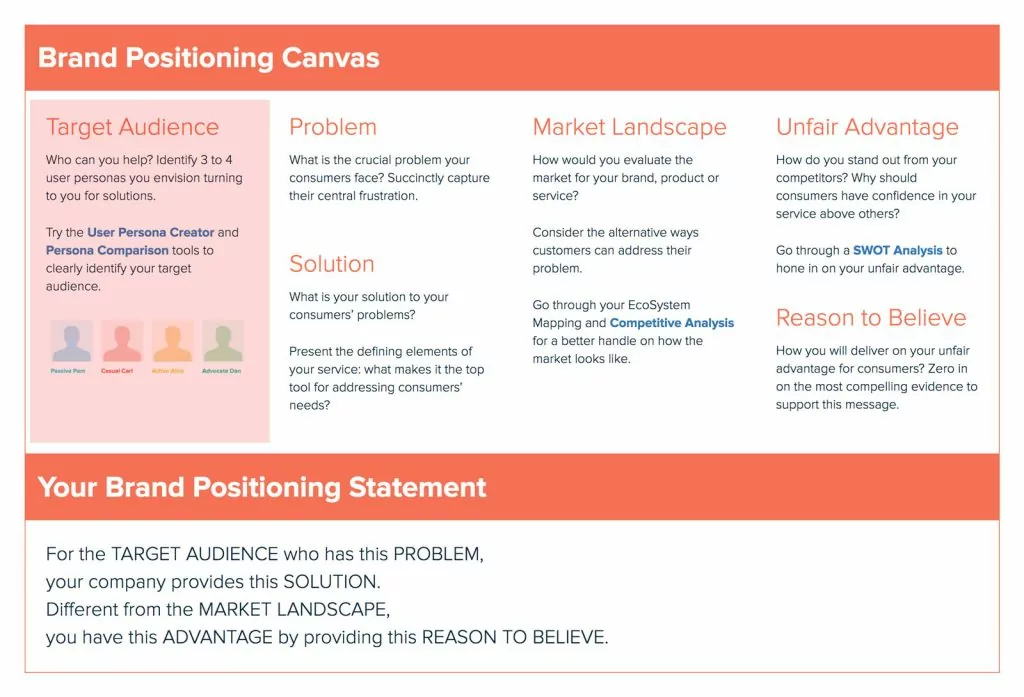
Problem
It’s essential to succinctly capture the problem you’re trying to solve. Without clearly interpreting the problem that you believe exists in the world, you can’t adequately explain how your product or service will solve it. That said, building a business around solving a specific problem is not always black-and-white. Occasionally, a more obvious problem might actually be a symptom of a greater underlying issue. Everyone and their mother knows about the “faster horses” analogy by now and has opinions about its merits. You can’t always drive business decisions by asking your customers what they want. A solution that drives an invention or an innovation comes from the “why” of it all. If you ask those same people why they need faster horses, they’d probably say something like, “I need to get to work faster.” Now that captures the essence of the issue right there!
Consider some of these questions to identify “the problem” that most affects your target audience:
- What obstacles do potential users face in solving the problem?
- Does the problem cost people time? Money? Both?
- Has something inefficient or ineffective become the norm and people don’t even realize it?
- Are other brands trying to address the same problem less successfully?

Solution
Are you effectively communicating what your solution is adding to your customers’ lives? Consider the ways your product or service is the best option available for your target audience.
- Is your solution thoroughly solving a problem?
- Does your solution fit in the marketplace like a glove? Meaning, does it compliment what’s already out there? Does it fill in a gap that the competition is leaving open?
- Is it an invention? Is it creating a new category in the market?
- Is it a disruptive solution? Will it turn the marketplace on its head, making competition irrelevant? If so, does it have the potential to create a range of problems of its own?
- What’s innovative about it?

Market Landscape
How will you fit in the market? Who are your biggest competitors? How is your audience currently solving “the problem”? Often, ideas are born in response to the rise of a dominant player in the marketplace. In other circumstances, company leaders will examine the market and enter with a similar offering but a clear differentiating point, competing head-on. Many businesses misjudge the competition in their market segment. It’s critical to anticipate where you’ll fit in the market landscape before deciding what will set you apart.
“Where there’s no competition, there’s no market. This is why startups who have “no competition” have trouble engaging partners and making sales. Your competitive set is part of your overall value proposition. So choose it with care… If you position yourself credibly relative to worthy alternatives, that speaks well on your behalf.”
— Geoffrey A. Moore, Escape Velocity
Keep in mind: Competitors validate that the problem you’re trying to solve has a market and that you have the potential to get a slice of that market by differentiating yourself well enough.
You can tap into Xtensio’s Competitive Analysis template to gain a deeper understanding of your competition. It will give you a good start in comparing the top players out there.
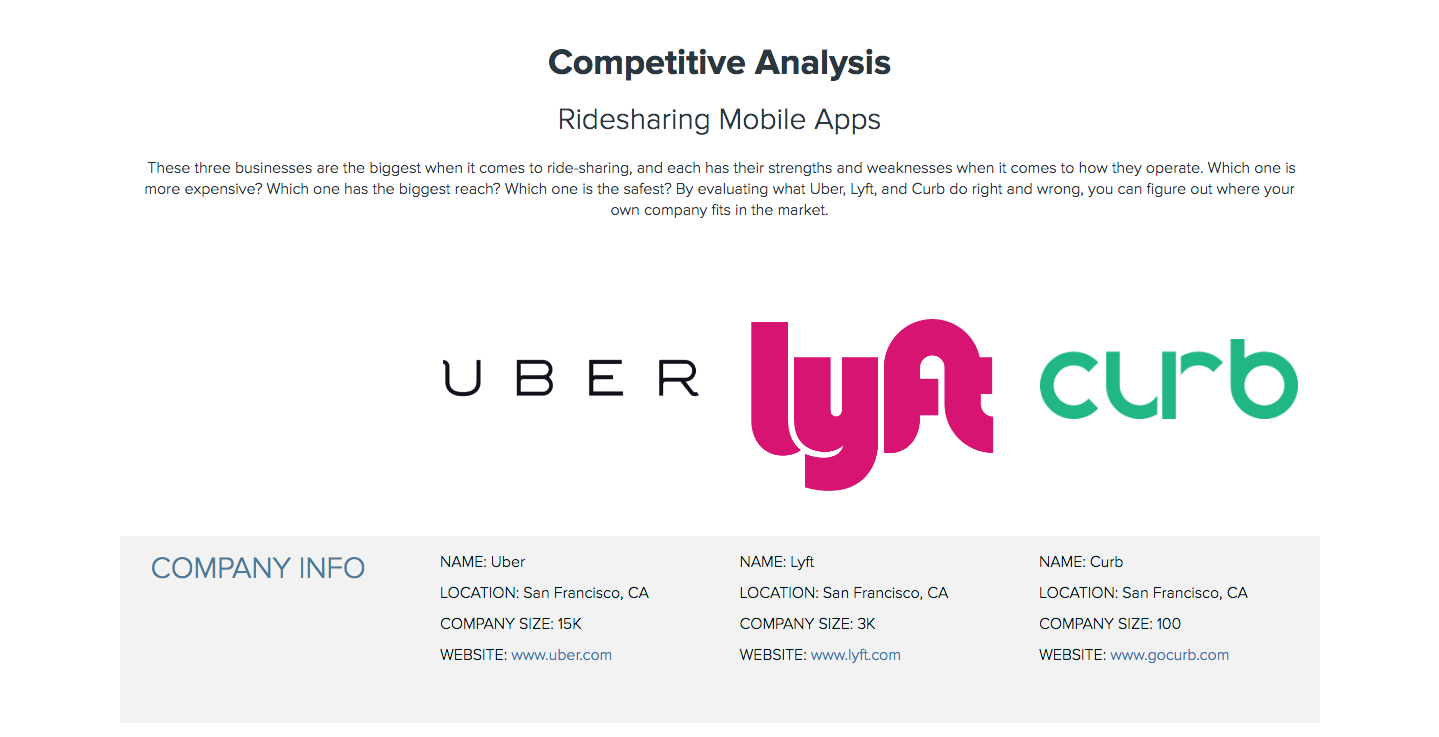

Unfair Advantage
Now that you have the lay of the land, you want to explain why your product or service is the best option for your target audience. Do you offer a feature that puts you ahead of the pack? Is your pricing structure more competitive? The distinguishing factors may be on your user-facing product offering, but they may also be all about what happens behind the scenes. Your talented and dedicated team, your unique expertise in the field, your processes, your efficiency, anything proprietary that you have created—whatever defines “your way” of doing business. By considering what distinguishes you from your competitors, you can start to think about how to convey those differences effectively.
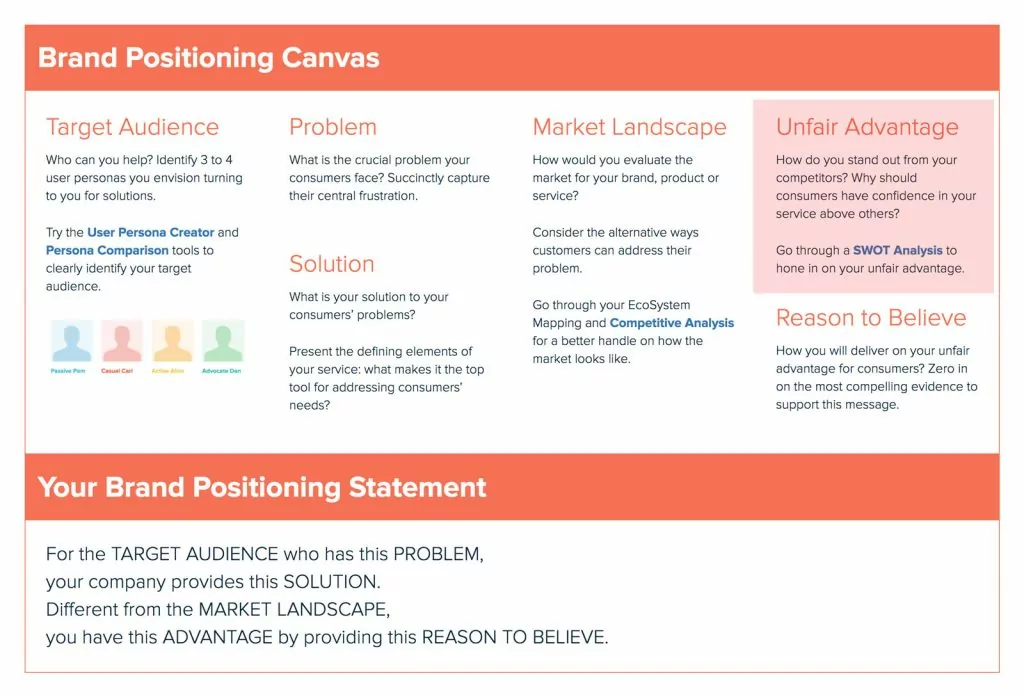
Reason to Believe
With a clear understanding of your Unfair Advantage, you can explain why people should use your product or service. The Reason to Believe is meant to be a compelling message to persuade users. What evidence can you point to that supports your Unfair Advantage? (If you’re having trouble filling out this section, you can work on Xtensio’s SWOT Analysis or alternative strategic planning tools to better understand your company’s strengths, weaknesses, opportunities and threats.)

Related how-to guides and free templates!
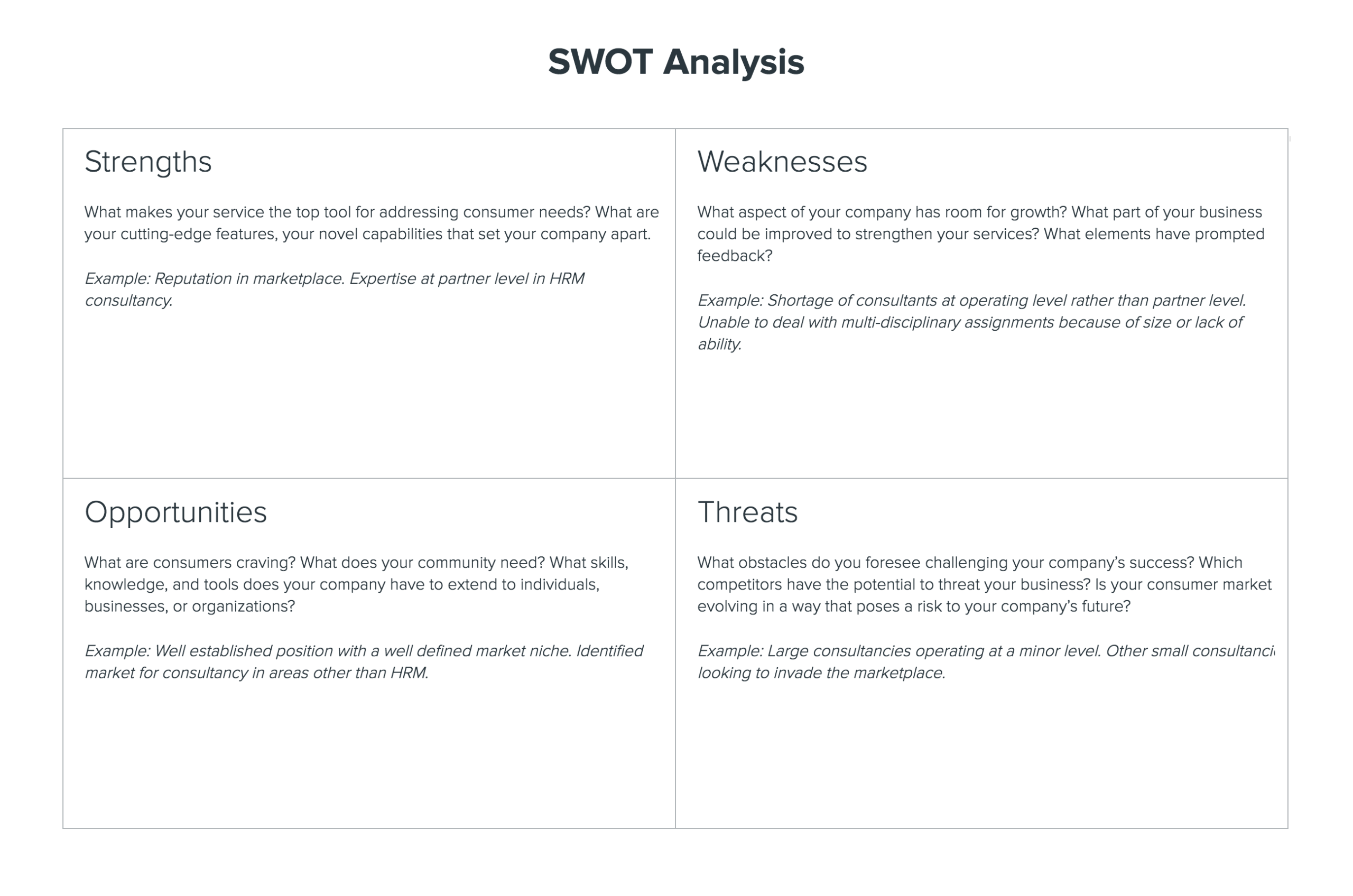
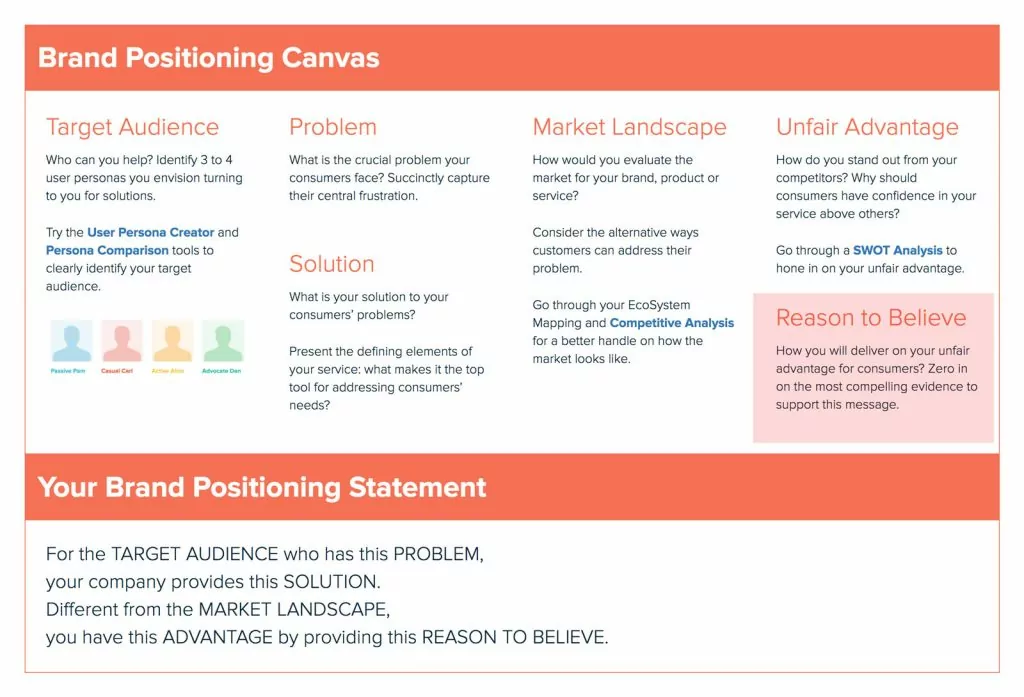
The Brand Positioning Statement
The goal of completing the Brand Positioning Canvas is to arrive at your brand positioning statement, a clear and concise explanation that will guide your team or company in how it makes decisions. This statement organizes the insights you’ve gleaned from going through this process.
“Avoid all buzzwords. If there’s one word that describes your positioning statement, it should be “human.”
Arielle Jackson, First Round Review
Here’s a suggested formula for creating your brand positioning statement:
For the TARGET AUDIENCE who has this PROBLEM, your company provides this SOLUTION. Different from the MARKET LANDSCAPE, you have this ADVANTAGE by providing this REASON TO BELIEVE.
Your statement isn’t meant to be used for your marketing, but it will inform those efforts. It won’t be your tagline, but your tagline should spring from it. Your brand guidelines stem from this overarching brand positioning statement, and guide the production of creative assets, external and internal facing marketing and communication materials. You can be flexible with how you format your brand positioning statement as long as you address the fundamental components of the brand positioning canvas.
For example, First Round Review highlights Amazon, which used the following positioning statement in 2001 when the company primarily sold books:
For World Wide Web users
Who enjoy books,
Amazon is a retail bookseller
That provides instant access to over 1.1 million books.
Unlike traditional book retailers,
Amazon provides a combination of extraordinary convenience, low prices and comprehensive selection.
And here’s one that Harley-Davidson shared publicly:
The only motorcycle manufacturer
That makes big, loud motorcycles
For macho guys (and “macho wannabes”)
Mostly in the United States
Who wants to join a gang of cowboys
In an era of decreasing personal freedom.
“What is going to be your claim to fame, the foundation of your unmatchable offer? To answer that question, you must declare your core.”
Geoffrey A. Moore, Escape Velocity

Bringing it all Together
Defining your brand positioning statement shapes your company’s product, messaging, design and unique value. For larger companies, the brand’s position is gospel; for startups, it provides focus amid growing pains and necessary pivots. The brand positioning statement becomes a resource when you’re faced with the question of whether or not a potential decision is “on brand”. The final statement at which you arrive is just the beginning of your work. What’s most important is the process by which you arrived at this statement, the research you conducted, all aspects of your product or service you weighed and prioritized. As your company evolves, your team grows, the marketplace transforms, there will be times to revisit and keep your anchor in check. Regularly update your ecosystem map, content strategy and conduct usability testing reports. Your positioning will help you stay true to the vision and sustain a strong brand presence.

Design, manage and share beautiful living documents… easily, together. Explore Xtensio
- Click and edit anything… together.
- Customize to match your branding.
- Share with a link, present, embed or download.
